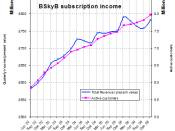analysis of tv industry in uk
The television industry in the U.K has seen a major change in its structure since the merger of Granada and Carlton. The pair have completed an 4.6 billion merger which is an major landmark in the television industry. The merger increases ITV television advertising market hold to 52%. This enlargement of the company has significantly increased ITV impact on the competitive side of the market. Mrs Hewitt regional franchises quoted "ITV would be better equipped to compete with rivals, including BSKYB and BBC."
ITV now seem stronger and able to invest in and provide programming of high quality. ITV clearly seem to be a new business now being able to compete more effectively in today's multi channel industry. However, having said that, the Carlton and Granada merge still have not managed to appoint a new chairman for ITV Plc. Since the removal of ex chairman Michael Green who was head of the new company board.
(2.2) Competition
The rivalry between ITV and BBC has been very intense towards the number 1 spot in the UK television industry. Previously BBC has had the honour of being and holding the number one spot. Although they still hold the number one spot, ITV has become and is remaining the most dominant channel at peak time hours taking a 31.6% share of the audience compared to BBC at 27.7%. ITV1 peak time line up is overcoming BBC1 schedule on 2 out every 3 evenings so far this year (67% of evenings). Moreover ITV1 has formed a bigger audience in peak time hours than all its commercial rivals can muster between them. ITV1 31.6% share equals to an average audience of 6.8million viewers compared to the other 6.4 million commercial share audience average. However, some commercial rivals such as...


